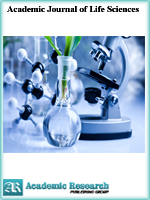Academic Journal of Life Sciences
Online ISSN: 2415-2137
Print ISSN: 2415-5217
Print ISSN: 2415-5217
Quarterly Published (4 Issues Per Year)

Archives
Volume 5 Number 10 October 2019
Acaricidal Activity of Nano-Abamectin Against the Two-Spotted Spider Mite; Tetranychus Urticae Koch (Acari: Tetranychidae)
Authors: Khaled Y. Abdel-Halim ; Fatma Sh. Kalmosh
Pages: 81-86
DOI: doi.org/10.32861/ajls.510.81.86
Abstract
The efficiency of prepared nano-abamectin was assayed against two-spotted spider mite, Tetranychus urticae (Koch). Prepared formulation showed spherical particles ranged from 66 to 133 nm under examination of Transmission Electron Microscope (TEM) and same pattern of Fourier Transform Infrared (FTIR) spectrum in comparison of conventional acaricide (Vertimecâ). In laboratory trail, toxicity index at LC50 level confirmed that nano-abamectin was greater toxic to adult female, T. urticae (Koch) with value; 30 than Vertimecâ 1.8% EC. Similarly, nano-abamectin reduced the mite fecundity at levels greater than those of Vertimecâ. Regarding field trail, nano-abamectin at rate of 60 ml/ha showed very toxic effects after 3 day of spraying followed by 7 and 14 days on soybean plants achieving % of mortality; 89.98, 83.80 and 76.90%, respectively. These findings showed that, bioactivity of nano-acaricide were many folds higher than conventional acaricide against mite, T. urticae (Koch). However, the biosafety issues may be also addressed.
Optimization of Hydrogen Gas Production Conditions from Egyptian Chlamydomonas Sp
Authors: Hanaa H. Abd El Baky ; Gamal S. El Baroty
Pages: 70-80
DOI: doi.org/10.32861/ajls.510.70.80
Abstract
Hydrogen gas could provide attractive options as ideal fuel for a world, in which environmental friendly and economically sustainable manner. Microalgae have the ability to bio-synthesis hydrogen gas. Algal H2 does do not generate any toxic or polluting bi-products and could potentially offer value-added products derived from algal biomass. In this work, the feasibility of coupling sulfur deprivation and light on hydrogen production by Chlamydomonas sp grown in photobioreactor was investigated. The cells growth, hydrogen production, total carbohydrate and chlorophyll content were determined. The results showed that, under optimum condition, algae cells were required 168 hr (7days) to reach the late logarithmic phase (the algal dry weight 4.11 g/L). Whereas the algae cells were needed about 18~22 days to reach this value (3.55 g/ L) when grow in optimum medium. The concentration of Chlorophyll (5.65%) and carbohydrate (39.46%) were accumulated in algae cells grow in S-deprives medium coupled with dark condition over that did in algae cells cultured in optimum medium. After about a 24 h of cultivation, photo-production of H2 was observed for C. sp either in absence or presence of sulfate. But under sulfur deprivation coupled with dark condition, higher H2 gas was obtained after 16 hr (7 several days) of incubation period. In new design photobioreactors (PhBRs), after 18 days of cultivation, the volume of H2 gas in was found to be 450 ml in cells grow in sulfur-deprived culture). This value was 360 ml in cells grow under optimal condition.



